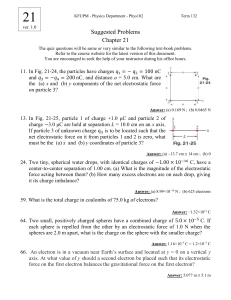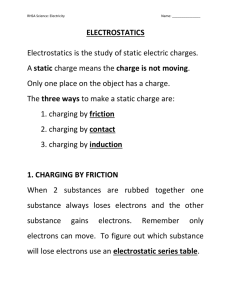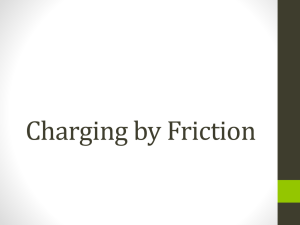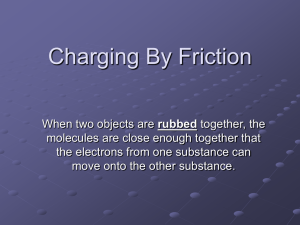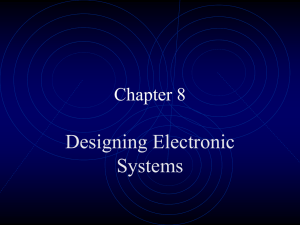Electrostatic Series and Charging by Friction Review
advertisement
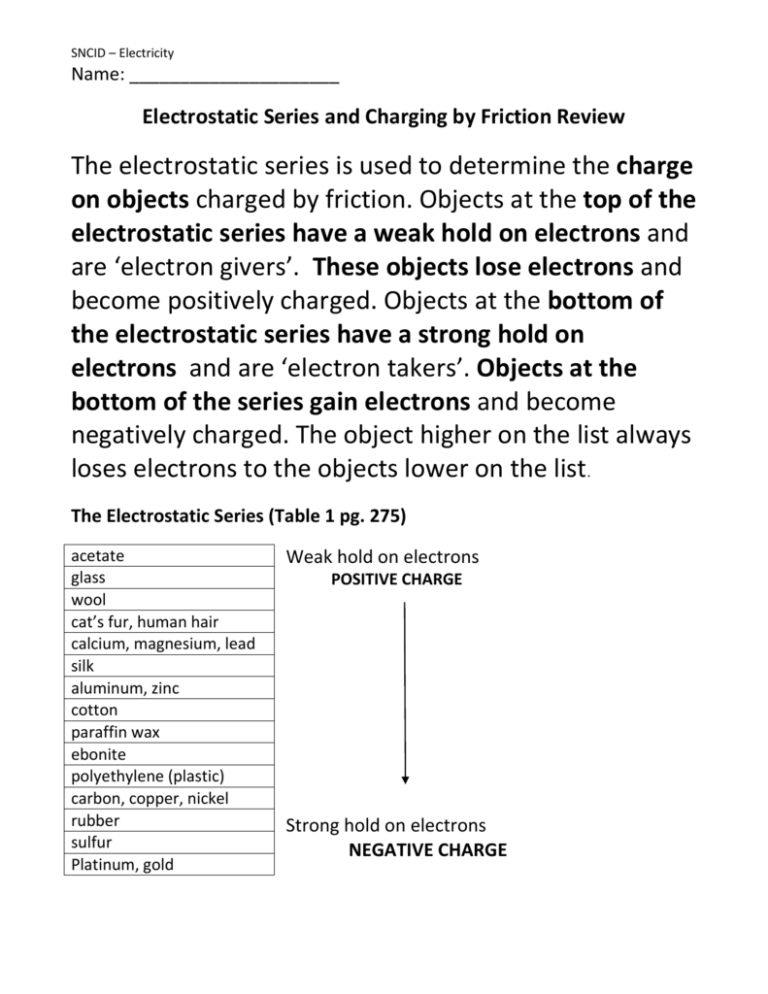
SNCID – Electricity Name: _____________________ Electrostatic Series and Charging by Friction Review The electrostatic series is used to determine the charge on objects charged by friction. Objects at the top of the electrostatic series have a weak hold on electrons and are ‘electron givers’. These objects lose electrons and become positively charged. Objects at the bottom of the electrostatic series have a strong hold on electrons and are ‘electron takers’. Objects at the bottom of the series gain electrons and become negatively charged. The object higher on the list always loses electrons to the objects lower on the list. The Electrostatic Series (Table 1 pg. 275) acetate glass wool cat’s fur, human hair calcium, magnesium, lead silk aluminum, zinc cotton paraffin wax ebonite polyethylene (plastic) carbon, copper, nickel rubber sulfur Platinum, gold Weak hold on electrons POSITIVE CHARGE Strong hold on electrons NEGATIVE CHARGE SNCID – Electricity Think If a piece of gold is rubbed with a piece of wool, which object loses electrons? Explain using the electrostatic series. The wool is at the top of the electrostatic series so will lose electrons and have a positive charge. The gold is lower on the electrostatic series so gold will gain electrons and have a negative charge. If a piece of gold is rubbed with a piece of wool, the wool loses electrons. The gold gains electrons. Wool is an electron giver and gold is an electron taker. Name one substance that will get a negative charge when rubbed on ebonite. Copper, rubber or gold Name one substance that will get a positive charge when rubbed on ebonite. acetate, glass, wool or human hair One piece of glass is rubbed with silk. A second piece of glass is rubbed with a rubber balloon. What will be the charge on both pieces of glass? The glass will have a positive charge when rubbed with either silk or rubber. SNCID – Electricity Which piece of glass will have a stronger charge and explain why. The glass rubbed with rubber will have a stronger positive charge because rubber and glass are further apart on the electrostatic series and more electrons will transfer. SNCID – Electricity Electrostatic Diagrams - Silk and Plastic Example BEFORE FRICTION __________________________ ______________________ __________________________ ______________________ Charging by Friction AFTER FRICTION __________________________ ______________________ __________________________ ______________________ Choose your own two substances from the electrostatic list and draw before and after friction electrostatic charge diagrams. ____________________ and _______________________ SNCID – Electricity Name: _____________________ Electrostatic Series and Charging by Friction Review Electrostatic Series The electrostatic series is used to determine the ______________________ _______________________________________ charged by friction. Objects at the _________________________________________________________ ___________________________ and are ‘electron givers’. ______________ _________________________________________ and become positively charged. Objects at the ___________________________________________ ___________________________________________________ and are ‘electron takers’. ________________________________________________ and become negatively charged. The objects higher on the list always loses electrons to the objects lower on the list. The Electrostatic Series (Table 1 pg. 275) acetate glass wool cat’s fur, human hair calcium, magnesium, lead silk aluminum, zinc cotton paraffin wax ebonite polyethylene (plastic) carbon, copper, nickel rubber sulfur Platinum, gold Weak hold on electrons ________________________________ Strong hold on electrons _____________________________ SNCID – Electricity Think If a piece of gold is rubbed with a piece of wool, which object loses electrons? Explain using the electrostatic series. _____________________________________________________ ____________________________________________________ _____________________________________________________ If a piece of gold is rubbed with a piece of wool, the wool ______________________________ ______________________________________________. The gold _______________ _________________________________________________________. Wool is an _____________________________ and gold is an __________________________________. Name one substance that will get a negative charge when rubbed on ebonite. _________________________________________ Name one substance that will get a positive charge when rubbed on ebonite. ____________________________________________ One piece of glass is rubbed with silk. A second piece of glass is rubbed with a rubber balloon. What will be the charge on both pieces of glass? __________________ Which piece of glass will have a stronger charge and explain why. ______________________________________________________ Electrostatic Diagrams - Silk and Plastic Example BEFORE FRICTION __________________________ ______________________ __________________________ ______________________ Charging by Friction SNCID – Electricity AFTER FRICTION __________________________ ______________________ __________________________ ______________________ Choose your own two substances from the electrostatic list and draw before and after friction electrostatic charge diagrams. ____________________ and _______________________
